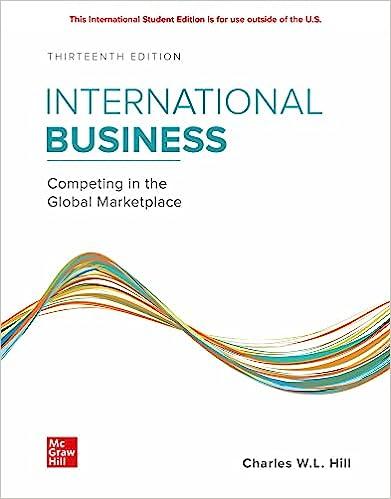When Walmart started to expand internationally in the early 1990s, the company set up an international division
Question:
In terms of reporting structure, the international division is divided into three regions—Europe, Asia, and the Americas—with the CEO of each region reporting to the CEO of the international division, who in turn reports to the CEO of Walmart. Initially, the senior management of the international division exerted tight centralized control over merchandising strategy and operations in different countries. The reasoning was straightforward: Walmart’s managers wanted to make sure that international stores copied the format for stores, merchandising, and operations that had served the company so well in the United States. They believed, naively perhaps, that centralized control over merchandising strategy and operations was the way to make sure this was the case.
By the late 1990s, with the international division approaching $20 billion in sales, Walmart’s managers concluded this centralized approach was not serving them well. Country managers had to get permission from their superiors in Bentonville before changing strategy and operations, and this was slowing decision making.
Centralization also produced information overload at the headquarters and led to some poor decisions. Walmart found that managers in Bentonville were not necessarily the best ones to decide on store layouts in Mexico, merchandising strategies in Argentina, or compensation policies in the United Kingdom. The need to adapt merchandising strategies and operations to local conditions was a strong argument for greater decentralization.
The pivotal event that led to a change in policy at Walmart was the company’s acquisition of Britain’s ASDA supermarket chain. The ASDA acquisition added a mature and successful $14 billion operation to Walmart’s international division. The company realized that it was not appropriate for managers in Bentonville to be making allimportant decisions for ASDA. Accordingly, the number of staff members located in Bentonville who were devoted to international operations was reduced by 50 percent. Country leaders were given greater responsibility, especially in the area of merchandising and operations. At that stage, Walmart was at the point where it was time to break away a little bit.
Company representatives said that “You can’t run the world from one place. The countries have to drive the business.”
Although Walmart has now decentralized decisions within the international division, it is still struggling to find the right formula for managing global sourcing. Ideally, the company would like to centralize sourcing in Bentonville, so it can use its enormous purchasing power to bargain down the prices it pays suppliers. As a practical matter, however, this has not been easy to attain, given that the product mix in Walmart stores has to be tailored to conditions prevailing in the local market. Currently, significant responsibility for sourcing remains at the country and regional level. However, Walmart would like to have a better and more efficient global sourcing strategy, such that it can negotiate on a global basis with key suppliers and can simultaneously introduce new merchandise into its stores around the world.
As merchandising and operating decisions have been decentralized, the international division has increasingly taken on a new role—that of identifying best practices and transferring them between countries. For example, the division has developed a knowledge management system whereby stores in one country—let’s say, Argentina—can quickly communicate pictures of items, sales data, and ideas on how to market and promote products to stores in another country —such as Japan.
Questions
1. As one of the largest companies in the world, Walmart has a reasonably limited international exposure—only 28 countries. What do you think Walmart can do to have a broader platform in more of the world’s 195 countries?
2. Walmart operates via a number of brands around the world (e.g., Asda in the United Kingdom). Many companies are becoming more and more standardized in their operations and have adopted organizational structures to support such standardization. Can Walmart adopt a more effective global strategy and, if so, what type of organizational structure should the company create to best serve its operations in the global marketplace?
3. Walmart Stores Chief Operating Officer Judith McKenna was named president and CEO of the company’s international unit effective February 1, 2018. The role is seen as a stepping stone to the top job at the world’s largest retailer, with current CEO Doug McMillon and his predecessor Mike Duke having run the international unit previously. If international is such an important part of the company, what can Walmart do, should do, or must do to leverage its position as the largest retailer in the world?
Step by Step Answer:

ISE International Business Competing In The Global Marketplace
ISBN: 9781260575866
13th International Edition
Authors: Charles Hill





